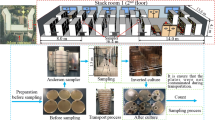Abstract
Indoor and outdoor airborne bacterialconcentrations were examined in an occupiedoffice building equipped with an airconditioning (HVAC) system, in Tempe, Arizona,USA. A two-stage microbial air sampler wasused to collect bacteria both inside andoutside the office at fixed locations in space,and at regular time intervals from August toDecember, 2000. Simultaneous measurement ofbacterial concentrations, temperature, relativehumidity, light intensity and wind speed wereperformed to explore the effects ofenvironmental factors on bacteria levels. Tengenera and twenty species of airborne bacteriawere found in our samples. AirborneGram-positive bacteria were most abundant, withmore than 90% of the measured population. Theparticle sizes of most outdoor and indoorairborne bacterial aerosols were larger than8.0 μm. According to the measurements ofeither a typical day or three consecutive days,the concentrations of outdoor airborne bacteriawere highest in the morning, but declined inthe afternoon and reached the lowest point inthe evening. With regard to the effects offour environmental factors – temperature,relative humidity, light intensity, and windspeed, the relative humidity had the mostpronounced influence on the outdoor bacterialconcentration, with the number of bacteriaincreasing sharply on a day of high relativehumidity.
Similar content being viewed by others
References
Agashe S.N.: 1994, 5th International Conference Bangalore. Aerobiology 419–425.
American Society of Heating, Refrigerating and Air-Conditioning Engineers: 2001, Ventilation for acceptable indoor air quality, ANSI/ASHRAE Standard 62-2001, ASHRAE, Atlanta, Georgia, USA.
Beaumont F., Kaufman H.F. and Sluiter H.J.: 1985, Sequential sampling of fungal air spores inside and outside the homes of mould-sensitive, asthmatic patients: A search for a relationship to obstructive reactions. Ann Allergy 55, 740–746.
Berglund B., Johansson I. and Lindvall T.: 1982, The influence of ventilation on indoor/outdoor air contaminants in an office. Environ. Int. 8, 395–399.
Brief R.S. and Bernath T.: 1988, Indoor pollution: Guidelines for prevention and control of microbiological respiratory hazards associated with air conditioning and ventilation systems. Applied Industrial Hygiene 3, 5–10.
Che F.X. et al.: 1988, Studies on airborne bacterial pollution in the atmosphere over Beijing area. Chinese Environmental Science 8, 70 (in Chinese).
Cox C.S. and Christopher M.: 1995, Bioaerosols Handbook. Lewis, Boca Raton, Florida.
Edmonds R.L.: 1979, Aerobiology: The Ecological System Approach. Dowden, Hutchingson and Ross.
Flannigan B., McCabe E.M. and Mcgarry F.: 1991, Allergenic and toxigenic micro-organisms in houses. J. Appl. Bacteriol. 70(Suppl), 61S–73S.
Gunnar R.L., Claus A. and Bond G.J.: 1990, Evaluation of children as sources of bioaerosols in a climate chamber study. Environ. Int. 16, 213–218.
Holt J.G., Krieg N.R., Sneath P.H.A., Staley J.T. and Williams S.T.: 1994, Bergey's Manual of Determinative Bacteriology (9th Edition). Williams and Wilkins, Baltimore, Maryland, USA.
Kodama A.M., McGee R.I.: 1986, Airborne microbial contaminants in indoor environments. Naturally ventilated and air conditioned homes. Arch. Environ. Health 41, 306–311.
Lighthart B.: 1994, Bacterial flux from chaparral into the atmosphere in mid-summer at a high desert location. Atmospheric Environment 28, 1267–1274.
Lundholm M.: 1982, Comparison of methods for quantitative determination of airborne bacteria and evaluation of total viable counts. Appl. Environ. Microbiol. 44, 179–183.
Marcinelli R.L. et al.: 1978, Airborne bacteria in an urban environment. Appl. Environ. Microbiol. 35, 1095–1101.
Miller J.D. et al.: 1992, Fungi as contaminants in indoor air. Atmospheric Environment 26A, 2163–2172.
MIDI: 2000, http://www.midi-inc.com.
Okuyama K., Kousaka Y., Yamamoto S. and Hosokawa T.: 1986, Particle loss of aerosols with particle diameters between 6 and 2000 nm in stirred tank. Journal of Colloid and Interface Science 110, 214–223.
Owen M.K., Ensor D.S. and Sparks L.E.: 1992, Airborne particle sizes and sources found in indoor air. Atmospheric Envir. 26, 2149–2162.
Ping R., Jankun T.M. and Leaderer B.P.: 1999, Comparisons of seasonal fungal prevalence in indoor and outdoor air and house dusts of dwellings in one Northeast American county. Journal of Exposure Analysis and Environmental Epidemiology 9, 560–568.
Robert E., Lee JR., Harris K. and Akland G.: 1973, Relationship between viable bacteria and air pollutants in an urban atmosphere. American Industrial Hygiene Association Journal 51, 601–604.
Robertson L.D.: 1998, Monitoring viable fungal and bacterial bioaerosol concentrations to identify acceptable levels for common indoor environments. Institute of Environmental Sciences and Technology, Contamination Control Proceedings of the 1998 44th Annual Technical Meeting, Phoenix, Arizona, USA, pp. 73–79.
Sanchez D.C., Mason M. and Norris C.: 1987, Methods and results of characterization of organic emissions from indoor material. Atmospheric Environment 21, 337–345.
Sheldon L.S., Sparacino C.M. and Pellizzari E.D.: 1985, Review of analytical methods for volatile organic compounds in the indoor environment. Indoor Air and Human Health 335–350.
Takanori T.: 1997, Airborne fungal colony-forming units in outdoor and indoor environments in Yokohama, Japan. Mycopathologia 139, 23–33.
Xie S.M. et al.: 1988, The composition of atmosphere microorganisms. J. Environmental Science 8, 39–47 (in Chinese).
Yocom J.E.: 1982, Indoor-outdoor air quality relationships: A critical review. J. Air Pollut. Control Assoc. 32, 500–520.
Yu X.H. and Che F.X.: 1998, Modern Air Microbiology and Sampling Detection and Identification Techniques, pp. 89–186 (in Chinese).
Author information
Authors and Affiliations
Corresponding author
Rights and permissions
About this article
Cite this article
Zhu, H., Phelan, P.E., Duan, T. et al. Experimental study of indoor and outdoor airborne bacterial concentrations in Tempe, Arizona, USA. Aerobiologia 19, 201–211 (2003). https://doi.org/10.1023/B:AERO.0000006571.23160.8a
Issue Date:
DOI: https://doi.org/10.1023/B:AERO.0000006571.23160.8a




